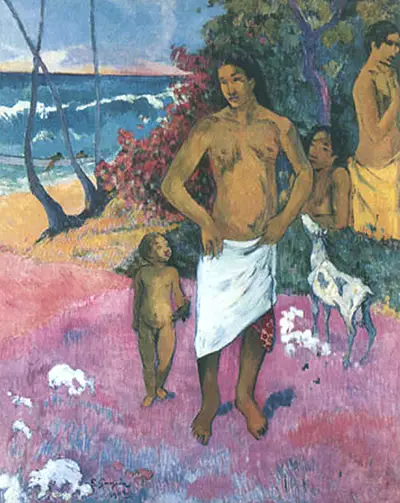In front of us here is a family enjoying a moment of rest and fun. Bathing was popular in Europe at this time, and clearly Tahitians were also doing similar. Life was slow paced on the island of Tahiti and people seemed pretty content. This is perhaps one of the charming elements of this place which attracted Gauguin to initially visit, and then to relocate here permanently at a later date. Animals would also be relatively free here, often depicted in the artist's work milling around without any real boundaries as such. The foreground of this piece is pink in tone, suggesting ground worn over time by humanity. As these figures walk around in virtually no clothes at all we can connect them with nature in a pure manner that the artist would struggle to find within his native Europe.
The artist would often add elements of the island into the backgrounds of his paintings. Here we find a beach with rolling waves which helps to set the scene of this location which was particularly exotic at this time for Europeans who would be excited by his artworks. Gauguin would struggle to get his art back to Europe and so would find trusted sellers back home whom he felt he could trust to take ownership of his work. He could then concentrate on continuing to work whilst also enjoying the beauty of his new home. Over time the artist would learn more about local people and their customs, and would become an accepted part of the local community even though his own character was known to be a little awkward from time to time. His work has helped us to learn more about life in Tahiti at this time.
There would be many more interesting artworks based on life in Tahiti from Gauguin's career. Some examples of his other famous paintings included Seed of the Areoi, When Will You Marry? and Washerwomen. He took inspiration initially from European painters during the early phases of his development before slowly incorporating other cultures which he learnt about as he travelled around. This fusion worked perfectly, but most would have been unable to put these different styles together effectively. He remains known as one of the most important French artists from the 19th century and his legacy is still very much felt in the present day, with his work still feeling relatively contemporary.

